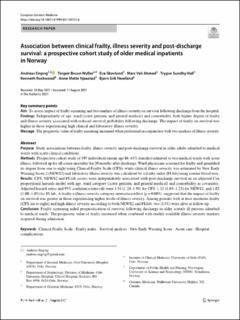| dc.contributor.author | Engvig, Andreas | |
| dc.contributor.author | Wyller, Torgeir Bruun | |
| dc.contributor.author | Skovlund, Eva | |
| dc.contributor.author | Ahmed, Marc Vali | |
| dc.contributor.author | Hall, Trygve Sundby | |
| dc.contributor.author | Rockwood, Kenneth | |
| dc.contributor.author | Njaastad, Anne Mette | |
| dc.contributor.author | Neerland, Bjørn Erik | |
| dc.date.accessioned | 2021-09-20T07:49:19Z | |
| dc.date.available | 2021-09-20T07:49:19Z | |
| dc.date.created | 2021-08-26T13:33:29Z | |
| dc.date.issued | 2021 | |
| dc.identifier.citation | European Geriatric Medicine. 2021, 1-9. | en_US |
| dc.identifier.issn | 1878-7649 | |
| dc.identifier.uri | https://hdl.handle.net/11250/2779073 | |
| dc.description.abstract | Purpose
Study associations between frailty, illness severity and post-discharge survival in older adults admitted to medical wards with acute clinical conditions.
Methods
Prospective cohort study of 195 individuals (mean age 86; 63% females) admitted to two medical wards with acute illness, followed up for all-cause mortality for 20 months after discharge. Ward physicians screened for frailty and quantified its degree from one to eight using Clinical Frailty Scale (CFS), while clinical illness severity was estimated by New Early Warning Score 2 (NEWS2) and laboratory illness severity was calculated by a frailty index (FI-lab) using routine blood tests.
Results
CFS, NEWS2 and FI-lab scores were independently associated with post-discharge survival in an adjusted Cox proportional hazards model with age, ward category (acute geriatric and general medical) and comorbidity as covariates. Adjusted hazard ratios and 95% confidence intervals were 1.54 (1.24–1.91) for CFS, 1.12 (1.03–1.23) for NEWS2, and 1.02 (1.00–1.05) for FI-lab. A frailty × illness severity category interaction effect (p = 0.003), suggested that the impact of frailty on survival was greater in those experiencing higher levels of illness severity. Among patients with at least moderate frailty (CFS six to eight) and high illness severity according to both NEWS2 and FI-lab, two (13%) were alive at follow-up.
Conclusion
Frailty screening aided prognostication of survival following discharge in older acutely ill persons admitted to medical wards. The prognostic value of frailty increased when combined with readily available illness severity markers acquired during admission. | en_US |
| dc.language.iso | eng | en_US |
| dc.publisher | Springer Nature | en_US |
| dc.rights | Navngivelse 4.0 Internasjonal | * |
| dc.rights.uri | http://creativecommons.org/licenses/by/4.0/deed.no | * |
| dc.title | Association between clinical frailty, illness severity and post-discharge survival: a prospective cohort study of older medical inpatients in Norway | en_US |
| dc.type | Peer reviewed | en_US |
| dc.type | Journal article | en_US |
| dc.description.version | publishedVersion | en_US |
| dc.source.pagenumber | 1-9 | en_US |
| dc.source.journal | European Geriatric Medicine | en_US |
| dc.identifier.doi | 10.1007/s41999-021-00555-8 | |
| dc.identifier.cristin | 1928976 | |
| dc.description.localcode | This article is licensed under a Creative Commons Attribution 4.0 International License, which permits use, sharing, adaptation, distribution and reproduction in any medium or format, as long as you give appropriate credit to the original author(s) and the source, provide a link to the Creative Commons licence, and indicate if changes were made. The images or other third party material in this article are included in the article's Creative Commons licence, unless indicated otherwise in a credit line to the material. If material is not included in the article's Creative Commons licence and your intended use is not permitted by statutory regulation or exceeds the permitted use, you will need to obtain permission directly from the copyright holder. To view a copy of this licence, visit http://creativecommons.org/licenses/by/4.0/. | en_US |
| cristin.ispublished | true | |
| cristin.fulltext | original | |
| cristin.qualitycode | 1 | |

